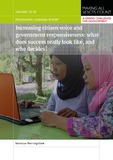| dc.contributor.author | Herringshaw, Vanessa | |
| dc.date.accessioned | 2018-01-19T12:10:48Z | |
| dc.date.available | 2018-01-19T12:10:48Z | |
| dc.date.issued | 2018-01 | |
| dc.identifier.citation | Herringshaw, V. (2018) Increasing citizen voice and government responsiveness: What does success really look like, and who decides?, Making All Voices Count Programme Learning Report, Brighton: IDS | en |
| dc.identifier.uri | https://opendocs.ids.ac.uk/opendocs/handle/20.500.12413/13472 | |
| dc.description.abstract | Narratives in the field of information and communications technology (ICT) for governance are full of claims, of either enormous success or almost none. But understanding ‘success’ and ‘failure’ depends on how these are framed. Research supported by Making All Voices Count suggests that different actors can seek very different goals from the same ICT-enabled interventions – some stated, some not.This programme learning report proposes two important dimensions for framing variations in visions of success for ICT-enabled governance interventions: (1) the kind of change in governance systems sought (‘functional’, ‘instrumental’, ‘transformative’ and ‘no change’); and (2) the vision of the ideal citizen–state relationship. It applies this framing to three areas where ICTs are being used, at least on paper, to encourage and channel citizen voice into governance processes, and to improve government responsiveness in return: participatory policy- and strategy-making; participatory budgeting; and citizen feedback to improve service delivery. In terms of the kind of change in governance systems sought, much of the rhetoric touts the use of ICTs as inherently ‘transformative’. However, findings suggest that it has mostly been deployed in ‘functional’, ‘instrumental’ and ‘no change’ ways. That said, the possibility of ICT-enabled ‘transformative’ change appears somewhat higher when citizens have more direct control over outcomes, and more online and offline processes are mixed and used in ways that foster collective, rather than individualised, inputs, deliberation and answerability. In terms of the vision of the state–citizen relationship, the findings show great variation in outcomes sought regarding the kinds and levels of participatory democracy, who this should benefit, the ideal size of the state, and the desired stability of actor groups and decision-making structures. The evidence suggests that the use of ICTs may have the potential to support change, including transformative change, but only when the political goals of key actors are pre-structured to support this. The choice of ICTs does matter to the effectiveness of this support, as does the way in which they are used. But overall, ICTs do not appear to be inherently ‘generative’ of change. They are, rather, ‘reflective’, ‘enabling’ or ‘amplifying’ of existing political agendas and levels of commitment. | en |
| dc.description.sponsorship | DFID | en |
| dc.description.sponsorship | USAID | en |
| dc.description.sponsorship | Sida | en |
| dc.description.sponsorship | Omidyar Network | en |
| dc.language.iso | en | en |
| dc.publisher | Institute of Development Studies | en |
| dc.relation.ispartofseries | Making All Voices Count Learning Report; | |
| dc.rights | Attribution-NonCommercial-NoDerivs 2.0 UK: England & Wales | * |
| dc.rights.uri | http://creativecommons.org/licenses/by-nc-nd/2.0/uk/ | * |
| dc.subject | Governance | en |
| dc.subject | Participation | en |
| dc.subject | Technology | en |
| dc.title | Increasing citizen voice and government responsiveness: What does success really look like, and who decides? | en |
| dc.type | Series paper (non-IDS) | en |
| dc.rights.holder | Institute of Development Studies | en |
| rioxxterms.funder | Default funder | en |
| rioxxterms.identifier.project | Default project | en |
| rioxxterms.version | NA | en |
| rioxxterms.funder.project | 9ce4e4dc-26e9-4d78-96e9-15e4dcac0642 | en |


